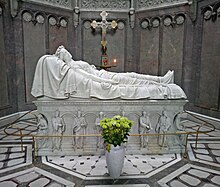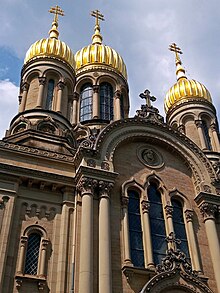Russian Orthodox Church (Wiesbaden)

The Russian Orthodox Church is the only Russian Orthodox church in Wiesbaden and is located on the Neroberg . Its full name is the Russian Orthodox Church of St. Elisabeth in Wiesbaden . In Wiesbaden, the term Greek chapel is also often used, because in the 19th century Orthodox churches were called "Greek churches". To the northeast of the Russian Church is the former caretaker's house, which is now used as a rectory, and a Russian Orthodox cemetery , which is one of the largest in Western Europe. The Russian Orthodox Church and its parish belongs to the Diocese of Germany of the Russian Orthodox Church Abroad .
history
The Russian Orthodox Church in Wiesbaden was built from 1847 to 1855 by Duke Adolf von Nassau on the occasion of the early death of his wife, the 18-year-old Russian Princess Jelisaveta Michailowna , Grand Duchess of Russia and Duchess of Nassau (1826-1845). This was the daughter of Michael Romanow (1798-1849), the younger brother of the Tsar Alexander I (reign: 1801 to 1825) and Nicholas I (reign: 1826 to 1855). Adolf had married the princess in 1844, but when she died with the child during the birth of their first child the following year, he fell into such grief that he decided to build a church of the Holy Sepulcher for her. He received the money for this church with the blessing of Tsar Nicholas I from her dowry .
The chief building officer Philipp Hoffmann was commissioned with the construction of the church, who initially studied Russian church construction in Russia. On May 25, 1855, the church was finally consecrated in honor of St. Elisabeth , mother of John the Baptist and name saint of the deceased. Shortly afterwards, the coffin with the deceased princess and the dead baby was transferred in a procession from the Bonifatius Church to the crypt of the Russian Church and buried there in a sarcophagus created by the sculptor Emil Hopfgarten . The dome frescoes of the church were created by the painter August Hopfgarten .
The Russian Orthodox cemetery was consecrated in 1856. It is located with the former guard's house about 100 meters northeast of the church. The pre-existing Russian Orthodox community settled in the church and consisted mainly of Russian guests, with Wiesbaden being a popular health resort in the 19th century. Tsar Nicholas II also visited the church with his wife, Tsarina Alexandra Feodorovna , during his stay in Germany and took part in the service. This event is noted on a gold plaque placed in the church.
In the 1990s, the interior of the church was completely restored, as the marble and frescoes in the church were exposed to weathering and other damage over time. Between 2002 and 2005 the interior of the crypt was renovated.
On the occasion of Vladimir Putin's visit to Wiesbaden in October 2007, the five golden domes were extensively cleaned and re-gilded for around 500,000 euros.
The community
A permanent congregation around the church did not emerge until the 1920s, when many Russian emigrants left their country and came to Germany as a result of the Russian Revolution , the Russian Civil War and the seizure of power by the Communists . Back then, Wiesbaden was one of the first places to go for immigrants from Russia, which had become atheist, and a community had formed. Since 1936 the church has belonged to the Russian Orthodox Diocese of Berlin and Germany , its head is Archbishop Mark .
architecture
The floor plan of the cross- domed church made of beige sandstone forms a square with an apse on the north side. The building is "crowned" by five fire-gilded domes , four smaller ones surrounding the large central dome. They have the onion shape typical of Russian churches and have vertical grooves. Fire-gilded Orthodox crosses sit on all domes, all of which face south and are the same size except for the larger central one.
All domes stand on round towers , with the central lantern tower being taller and larger in diameter. It is provided in the octagon below the dome with narrow vertical windows through which light can enter the church. The surrounding smaller towers repeat the shape of the lantern tower, but each have only four windows alternating with blind windows and are not connected to the interior. The north-eastern tower has a spiral staircase that allows access to under the central dome. From there a small door leads to the roof of the church.
The church has two entrances, the south and the west entrance. The south entrance was originally intended only for the princes . It was closed forever after the overthrow of the last Tsar Nicholas II in 1917. Until then, the visitor was offered the panorama of Wiesbaden when stepping out of the church . The west entrance is now used as the main entrance and used to be the entrance for the "common people". The entrances, which are elevated up to ten steps, are each spanned by an arch that rests on a pair of columns on each side . The stairs are made of red sandstone.
When the visitor enters the church, he is - as is usual in most Russian Orthodox churches - directly opposite the iconostasis . Above the entrances there are medallions made from sandstone. Above the west entrance this is the medallion of Saint Helena , at the south entrance that of Saint Elizabeth (to whom the church is also consecrated) and on the east side above the window to the chancel that of Saint Archangel Michael . These saints were the patron saints of the father ( Michail ) and mother ( Helena ) of the Grand Duchess and her patron saint herself ( Elisabeth ).
Iconostasis
The iconostasis comes from Carl Timoleon von Neff , who fundamentally changed the style of icon painting in the style of Tsar Peter the Great and made it accessible to Western influences. It resembles the romantic-religious painting of the Nazarenes. In Russia he received numerous commissions from the Orthodox Church. For example, he made the iconostases of St. Petersburg's Isaac Cathedral or that of the former Church of the Savior in Moscow. When Duke Adolf von Nassau had the grave church built for his wife, Neff was commissioned to paint the pictures of the iconostasis. To the right of the royal gate are the representations of Jesus Christ , the Archangel Michael , St. Elizabeth and St. Nicholas . To the left of the royal gate are Mary with the child, the Archangel Gabriel , St. Helena and St. Catherine . In the row above you can see the Lord's Supper in the middle , to the right of it the portraits of Saints John Chrysostom , Maria Magdalena , Vladimir and Alexandra , to the left of them Saints Basil , Anna , Constantine and George . The third shows the apostles Peter and Paul and the evangelists John , Mark , Luke , and Matthew . Next to Alexej Jawlensky, Neff is the second Russian painter from whom Wiesbaden can show an important work. The portrait of Neff - a relief in a medallion - is inside the Russian Church, to the left of the southern door. It was created by the stonemason Johann-Peter Leonhard (1793–1873). The paintings on the altar walls of the Russian churches in Bad Ems, Darmstadt, Helsinki, Edinburgh, London and Nice come from Neff's hand.
graveyard
The Russian Orthodox cemetery is located near the Church of St. Elizabeth. It is one of the oldest of its kind in Western Europe and has been owned by the Russian Orthodox Church since 1864. It has been expanded several times over the years, most recently in 1977. The cemetery is located in the neighboring forest, about 200 meters northeast of the church. It can be viewed in the church on request. In 2009 and 2010 parts of the cemetery were renovated, fallen tombstones erected, damaged sections of the cemetery wall repaired and the sandstone portal restored.
The Russian Orthodox Fund e.V. tries to maintain and maintain the cemetery . V. , Wiesbaden. The association sees its main task in drawing attention to the cultural monument of European importance.
Trivia
The church building has been honored twice on postage stamps of the German Federal Post Office in the permanent series Sights .
In addition, there is an illustration on the tourist information signs (information boards) on the motorways around Wiesbaden.
literature

- Russian church on the Neroberge in Wiesbaden - historical overview and description of the church. Self-published by the church council, 1925.
- Erik Thomson: Karl Timoleon von Neff and the Russian Church on the Neroberg in Wiesbaden. In: Hessian homeland. 14. Vol. 3, 1964, p. 23ff.
- Alexander Hildebrand: Romantic symbol of immortality, symmetry in all parts. The Russian Orthodox Cathedral in Wiesbaden. In: Wiesbaden life. 8/1994, p. 32f.
- Wiesbaden - Russian Church, Monastery of St. Job von Počaev in Munich. 3rd edition, Berlin / Munich 2000, ISBN 3-926165-95-2 .
- Baedeker Wiesbaden Rheingau. Karl Baedeker, Ostfildern-Kemnat 2001, ISBN 3-87954-076-4 .
- Gottfried Kiesow: The misunderstood century. Historicism using the example of Wiesbaden. German Foundation for Monument Protection, 2005, ISBN 3-936942-53-6 .
- Dr. Dirk Becker: vivat Wiesbaden. Walks between tradition and modernity. A city guide for Wiesbaden and the surrounding area. Universum Verlag, Wiesbaden 2006, ISBN 3-89869-141-1 .
- Marc Peschke: Wiesbaden. In: Marc Peschke u. a .: Rheingau & Wiesbaden. Travel and wine guides. Verlag Bernd Ditter, Wiesbaden 2006, ISBN 3-934962-06-8 .
- Marina Vershevskaya: Graves tell a story. The Russian Orthodox Church of St. Elisabeth and her cemetery in Wiesbaden. Published by the Kur- und Verkehrsverein Wiesbaden e. V. Translated from Russian by Maja Speransky. EDITION 6065, Wiesbaden 2006, ISBN 3-9808639-7-2 .
Web links
- Church history PDF document
- "Website of the Russian Orthodox Church in Wiesbaden" (Russian)
- 360 ° panorama of the church, Wiesbadener Kurier
- Russian Orthodox Fund e. V.
Individual evidence
- ↑ Georg Dehio : Handbook of the German art monuments - Hessen II: The administrative district Darmstadt . S. 813. Deutscher Kunstverlag Munich 2008, ISBN 978-3-422-03117-3
- ^ Martyr, wife of the Roman emperor Diocletian
- ↑ Bernd Fäthke: Marianne Werefkin. Munich 2001, p. 16, Fig. 13
- ↑ FAZ of September 23, 2010, p. 57.
Coordinates: 50 ° 5 ′ 51 ″ N , 8 ° 14 ′ 5 ″ E









